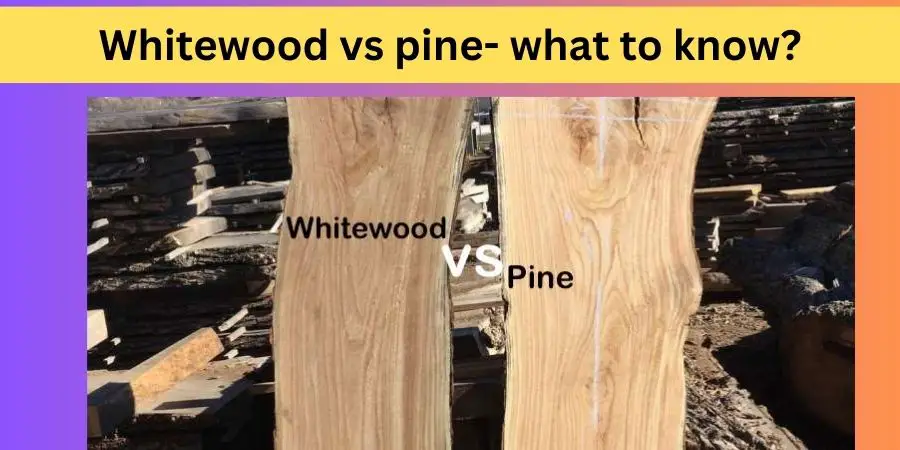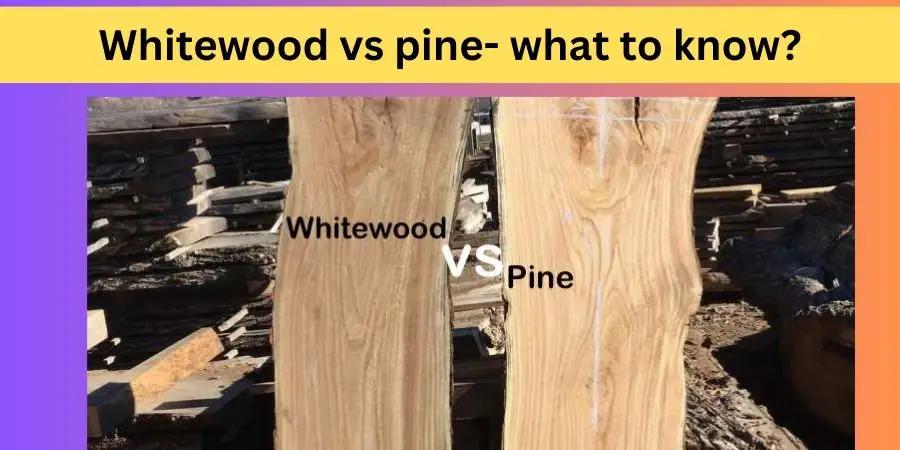Are you stuck between choosing whitewood or pine for your project? Let’s dive into the differences and help you make an informed decision.
Whitewood vs Pinewood- what to know?

Whitewood, as a general term for several types of softwood, can vary in appearance depending on the specific species of tree. However, in general, whitewood is a light-colored wood with a relatively consistent grain pattern. This makes it a popular choice for painting or staining, as it takes on color well and has a relatively uniform appearance.
Pine, on the other hand, is a specific species of tree in the Pinus genus. It can range in color from light yellow to reddish-brown, and it has a more distinct and visible grain pattern than whitewood. Pine also tends to have knots and other imperfections in the wood, which can add character and visual interest to the finished product.
Pros of Whitewood:
- Light in weight, making it easy to work with
- Low cost compared to many other types of wood
- Has a pale, even color that can be easily stained or painted
- Can be found in large sizes, making it suitable for larger projects
Cons of Whitewood:
- Not as strong or durable as other types of wood
- May contain knots, which can weaken the wood and make it less attractive for certain projects
- Prone to warping or cracking over time
When to use Whitewood:
- Suitable for indoor furniture and decorative projects
- Ideal for projects where a light weight is desirable, such as model making or small crafts
- Can be used for non-structural construction, such as wall paneling or decorative moldings
When to avoid Whitewood:
- Not recommended for projects where strength and durability are a priority
- May not be suitable for outdoor use or projects exposed to moisture
Pros of Pinewood:
- Strong and durable, making it suitable for a range of projects
- Affordable and widely available
- Easy to work with and finish
- Has a warm, natural look that can be left unfinished or stained
Cons of Pinewood:
- Can contain knots or other defects that can weaken the wood or make it less attractive for certain projects
- Can be prone to warping or splitting over time
- May not have a consistent color or grain pattern
When to use Pinewood:
- Ideal for indoor and outdoor construction, including framing, decking, and fencing
- Suitable for furniture and decorative projects, especially when a rustic or natural look is desired
- Can be used for flooring, especially when durability is a priority
When to avoid Pinewood:
- Not recommended for projects requiring extreme strength or durability
- May not be suitable for projects requiring a uniform appearance or consistent color
Strength of Whitewood compared to Pinewood:
Density and Weight: Whitewood is less dense and lighter in weight than pinewood. This means that it is not as strong and durable as pinewood, and is more prone to damage and wear over time.
Tensile Strength: Whitewood has a lower tensile strength than pinewood, which means that it is less able to resist pulling or stretching forces. This can make it less suitable for load-bearing applications, such as structural framing.
Compression Strength: Similarly, whitewood also has a lower compression strength than pinewood, which means that it is less able to withstand compressive forces. This can make it more prone to damage and deformation over time.
Bending Strength: Whitewood also has a lower bending strength than pinewood, which means that it is less able to resist bending and flexing forces. This can make it less suitable for applications that require a high degree of rigidity and stability, such as flooring or decking
How strong is whitewood compared to pinewood?
Whitewood and pinewood have different strength characteristics. Here is some information on their relative strength:
Whitewood: Whitewood, also known as spruce, is a softwood with a Janka hardness rating of 380 lbf. This means that it is a relatively soft and easy-to-work wood. While it is not as strong as some hardwoods, such as oak or maple, it is still strong enough for many applications.
Pinewood: Pinewood is a softwood with a Janka hardness rating of 380-420 lbf. This makes it slightly harder than whitewood, although the difference in strength is not significant. Pinewood is commonly used for structural framing, support beams, and other load-bearing applications due to its strength and durability.
while pinewood is slightly stronger than whitewood, both woods are suitable for many applications and their strength characteristics should be evaluated in the context of the specific project.
Applications of whitewood
Decorative Use: Whitewood is often used for trim, molding, and paneling to create a simple and clean look due to its smooth and consistent appearance.
Furniture Making: Whitewood is a popular choice in furniture making due to its light color and easy-to-paint or stain surface. It can also be shaped and carved into intricate designs.
Interior Finishing: Whitewood is commonly used for baseboards, crown molding, and other decorative trims in the construction of doors, windows, and other interior finishes.
Applications of pinewood
Structural Framing: Pinewood is commonly used for structural framing in construction. It is strong and durable, making it a good choice for load-bearing applications.
Support Beams: Pinewood is often used for support beams in construction projects. It is capable of bearing heavy loads and can span long distances.
Decking: Pinewood is a popular choice for decking because of its natural beauty and durability. It is resistant to moisture and can withstand outdoor elements.
Exterior Finishes: Pinewood is commonly used for exterior finishes such as siding, roofing, and fencing. It is resistant to decay and insect damage, making it a good choice for outdoor applications.
Furniture Making: Pinewood is a popular choice for furniture making because of its strength and affordability. It can be easily painted or stained to achieve different finishes and styles.
How can the durability of whitewood and pinewood be improved?
A: Both whitewood and pinewood can be treated with preservatives to improve their durability and lifespan. This includes pressure treatment with chemicals that protect against decay and insect damage. It is important to follow the manufacturer’s instructions for proper treatment and handling.





